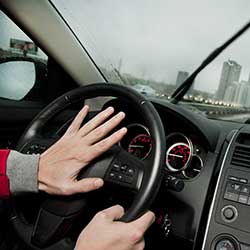
Aggressive Driving
- August 31
- EVANS / DESHAZO / REILLEY
- Car Accidents
During a recent morning rush hour in Allen, Texas, a man fired a gun at a driver in front of him, because she had allegedly cut him off in traffic. He fired four shots – through his own windshield – that pierced her back window, and one of the bullets grazed the woman’s dashboard. Neither driver was injured, and police later arrested the man.
This incident is an extreme example of “road rage” – a problem that’s becoming increasingly common, especially in and around Dallas. It begins with aggressive drivers, and when they lose their temper, they may become involved in deadly altercations with other drivers.
Often, people who are prone to aggressive driving become more agitated when stuck in traffic. They may follow cars too closely, weave in and out of lanes, cut off other drivers, or pass other drivers by driving on the shoulder of the road. All of these behaviors can increase the risk of a crash, as well as enrage other aggressive drivers on the road.
Here’s one reason aggressive driving is such a problem: Many aggressive drivers don’t recognize their own behavior as aggressive. There are some behaviors, though, that could indicate drivers need to work on being more relaxed behind the wheel:
- Routinely running yellow lights
- Refusing to let people merge
- Honking at cars that are slow to respond to a green light
- Yelling at other drivers.
Results of Aggression
According to the Texas Department of Transportation, in 2014, changing lanes when it was unsafe to do so was a contributing factor in 29,571 Texas crashes, 54 of which were fatal. Following too closely – or tailgating – was a factor in 23,850 crashes, 25 of which were fatal.
When you encounter an aggressive driver, the Texas DOT recommends trying to minimize interaction. Don’t make eye contact, don’t verbally engage the other driver, and don’t make faces or gestures. If a car is moving aggressively through traffic, give that driver plenty of space. And if you feel like you’re in danger, and you can safely use your cell phone, call the police.
Staying Calm While Driving
When another driver puts you in danger by tailgating you or cutting you off in traffic, it’s natural to feel angry. But allowing emotions to escalate can lead to dangerous interactions with other drivers. The AAA Foundation for Traffic Safety recommends a few strategies for quashing feelings of anger before they become a problem:
- If another driver cuts you off, think of the phrase, “Be my guest.”
- If you’re tempted to retaliate against a driver who’s driving aggressively, ask yourself, “Would I want to fly in an airplane if its pilot was acting like this?”
- Try to imagine why another person is driving aggressively – maybe he or she just had a bad day
Most everyone has experienced the anxiety of trying to get somewhere in a hurry and being stuck in traffic. To reduce feelings of stress that could lead to unsafe driving, always leave earlier than necessary.
Cars and Etiquette
If you’re standing in line at a coffee shop and someone steps in front of you, you might not say anything at all, or you might politely point out to that person that you are in line. But in a car, people seem to react much more strongly to the same type of situation, sometimes yelling obscenities at a driver who isn’t even aware of the perceived injustice that just occurred.
Drivers could reduce aggression and road rage by observing the same etiquette in their cars that they use when they encounter people face to face.

 Serving Clients Throughout Texas
Serving Clients Throughout Texas
 Chip Evans is a partner at Evans & Herlihy. Chip brings to the firm more than 20 years of experience as a trial lawyer representing Plaintiffs. It is the desire to help individuals, not corporations, that attracts Chip to this side of the docket. [
Chip Evans is a partner at Evans & Herlihy. Chip brings to the firm more than 20 years of experience as a trial lawyer representing Plaintiffs. It is the desire to help individuals, not corporations, that attracts Chip to this side of the docket. [